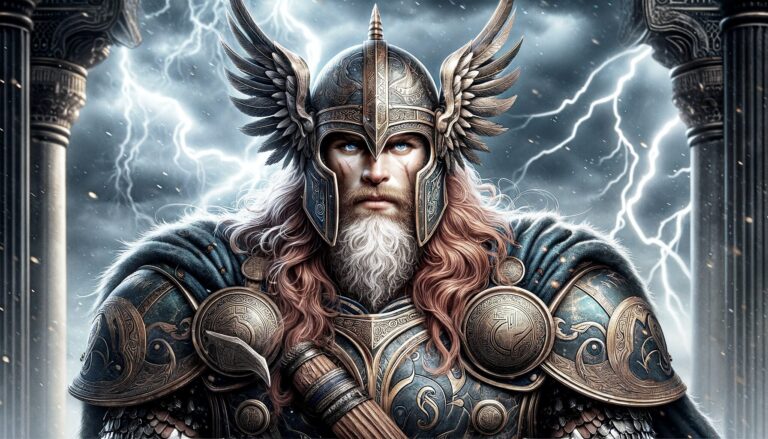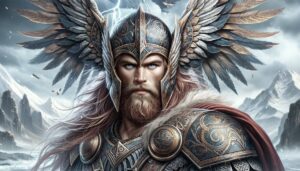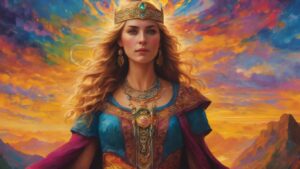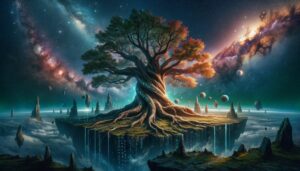Table of Contents
In the pantheon of Norse mythology, amidst the frosty landscapes and rugged fjords of the ancient North, one deity stands out with a commanding presence. Thor, the mighty Thunder God, is a figure of immense power, courage, and resilience.
Origins and Family
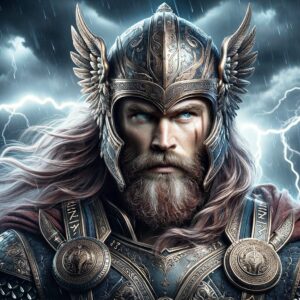
Thor’s lineage can be traced to the divine family tree of Norse mythology. He is the son of Odin, the chief of the gods, and Jord (or Fjorgyn), the personification of the Earth. This connection to the Earth underscores Thor’s natural affinity with the elements and the physical world. Thor is often considered the protector of both gods and humans, and his familial ties reflect his role as a guardian figure.
In addition to his divine parentage, Thor has a well-known brother named Baldr, a god associated with light and purity. Baldr’s contrasting attributes highlight the duality often found in mythological narratives – the benevolent and the fierce, the light and the storm.
Appearance
Thor is often depicted as a hulking, red-bearded warrior, exuding a sense of raw power. His robust physique mirrors his role as the god of thunder and strength. He typically dons the attire of a Norse warrior, complete with a distinctive winged helmet, a symbol of his thunderous presence in the skies.
One of Thor’s most iconic possessions is his formidable weapon, Mjölnir, a mighty hammer. This hammer is not just a weapon but also a symbol of protection, fertility, and the power to hallow. Mjölnir’s short handle and bulky head make it an instantly recognizable symbol of Thor’s strength. The hammer is known for its ability to summon thunder and lightning when thrown and always returning to its master’s hand, a manifestation of Thor’s authority over storms.
Abilities
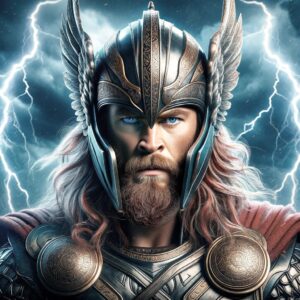
Thor’s abilities are as awe-inspiring as his appearance. Furthermore, as the Thunder God, he commands the forces of thunder and lightning, with the ability to create fierce storms at will. In addition, his hammer, Mjölnir, is not just a physical weapon; it symbolizes his dominion over thunderbolts and his ability to protect the realms of gods and humans from the chaotic forces of giants and other threats.
Thor’s role as a protector extends beyond the celestial realm. He is often invoked by seafarers and travelers to ensure safe journeys, as he has power over weather and natural elements. Thor’s protection also encompasses the defense of Asgard, the realm of the gods, from the encroachment of giants and other menacing beings. In this role, he is the guardian of divine order and cosmic stability.
Symbolic Interpretations
Thor’s symbolism runs deep and reflects various facets of human existence and the natural world. Furthermore, his hammer, Mjölnir, is emblematic of protection and fertility. Additionally, the act of wielding Mjölnir and summoning lightning symbolizes the human endeavor to harness the forces of nature, highlighting mankind’s innate connection to the elements.
Furthermore, Thor’s role as a protector underscores the human desire for safety and security in a world filled with uncertainties. His association with thunder and lightning reflects the awe and wonder inspired by natural phenomena, reminding us of our connection to the cosmos.
Cultural Impact
Thor’s enduring presence in Norse mythology has left an indelible mark on the cultural heritage of the Nordic and Germanic peoples. His tales continue to resonate in modern popular culture, from literature to film, and his character is celebrated in various forms.
One of the most significant cultural references to Thor is in Marvel Comics and the Marvel Cinematic Universe (MCU). The character Thor, portrayed by actor Chris Hemsworth, has become an iconic figure in contemporary cinema, introducing the Thunder God to a global audience. While the Marvel version of Thor takes creative liberties with the mythology, it showcases the enduring appeal and fascination with this ancient deity.
In literature, Thor’s adventures and struggles against formidable adversaries have inspired countless authors and storytellers. His portrayal as a hero who confronts overwhelming odds resonates with themes of bravery and resilience that captivate readers of all ages.
Myths and Stories
The myths and stories surrounding Thor are as diverse as they are captivating, each shedding light on different aspects of his character and his pivotal role in the Norse pantheon. Here are some notable myths and stories featuring Thor:
Thor and the Jotnar
The story begins with a daunting mission. Thor, the protector of the gods and humans, was preparing for an epic battle against the Midgard Serpent, a colossal sea creature whose coiled presence threatened the very fabric of the cosmos. To ensure victory in this monumental clash, Thor required a specific and extraordinary bait—the severed head of an ox.
Thor’s choice of fishing companion was equally extraordinary. Notably, Hymir, a giant of immense stature, possessed a colossal cauldron capable of holding unimaginable amounts of bait. The two unlikely partners set out to sea, Thor’s intentions as clear as the stormy skies above: to confront the Midgard Serpent and protect the realms.
Their fishing expedition, however, was anything but ordinary. Thor wielded a colossal fishing rod, more akin to a tree trunk than a delicate instrument, and his fishing line was not a flimsy thread but a sturdy cable of divine strength. Additionally, with the ox’s head as bait, they cast their line into the depths of the ocean, its vast expanse reflecting the enormity of their task.
As they fished, the tension in the air was palpable. Furthermore, the sea churned and roiled, and the Midgard Serpent took the bait. Consequently, a titanic struggle ensued, as Thor and the serpent engaged in a fierce battle of wills and strength. Ultimately, the fishing trip became a test of Thor’s might, determination, and unwavering resolve.
The story of Thor’s fishing expedition with Hymir not only illustrates his incredible strength but also showcases his willingness to confront formidable adversaries, no matter how daunting the task. It serves as a testament to Thor’s commitment to protecting the realms of gods and humans, even in the face of cosmic peril.
Thor’s Journey to Utgard-Loki’s Court
In the annals of Norse mythology, one of the most captivating stories featuring the Thunder God Thor unfolds during his journey to Utgard-Loki’s court, the realm of the giants. Accompanied by his mischievous companion, Loki, Thor embarks on an adventure that will test not only his immense strength but also his determination and unyielding spirit.
Upon their arrival in the land of the giants, Thor and Loki are greeted with skepticism and challenges by the inhabitants. Utgard-Loki, the cunning giant king, sets a series of seemingly insurmountable tasks and illusions before the two visitors, each designed to humble the Thunder God.
One challenge involves a drinking contest in which Thor, renowned for his ability to consume vast quantities of mead, finds himself outmatched. Another trial is a wrestling match, during which Thor struggles against an elderly-looking giant but fails to win. Utgard-Loki’s final challenge takes the form of a simple cat-lifting contest, and despite Thor’s immense efforts, he can barely raise one of the cat’s paws off the ground.
As Thor and Loki depart from Utgard-Loki’s realm, they learn the truth behind the challenges—they were not as they appeared. The giant king had orchestrated clever illusions to diminish Thor’s confidence. Despite these setbacks, Thor’s determination and indomitable spirit shine through, emphasizing his unwavering resolve in the face of seemingly insurmountable obstacles.
Thor’s Battle with the World-Serpent
In the tumultuous events of Ragnarök, the apocalyptic battle that heralds the end of the Norse cosmos, Thor faces his most formidable adversary—the Midgard Serpent. This colossal sea creature, coiled around the world itself, embodies chaos and impending doom.
Additionally, as the forces of chaos and destruction converge, Thor confronts the Midgard Serpent in a cataclysmic showdown of titanic proportions. The thunderous clash reverberates across the cosmos as Thor hurls his mighty hammer, Mjölnir, against the serpent, summoning the full force of his divine power. In response, the serpent strikes back with venomous fury, its poison searing through Thor’s veins.
Their battle is fierce and unrelenting. In the end, it results in mutual destruction. Thor’s mighty blows and the serpent’s venomous bite lead to their simultaneous downfall. It’s a poignant and tragic moment, underscoring the inevitability of cosmic cycles and the sacrifices made by divine beings to preserve the delicate balance of the cosmos.
Thor’s Duel with Hrungnir
Thor’s duel with the giant Hrungnir stands as a testament to the Thunder God’s unyielding bravery and unwavering valor. The story unfolds as Thor, the protector of both gods and humans, is faced with a formidable adversary, Hrungnir, a giant of extraordinary strength and cunning.
What makes this duel particularly noteworthy is Hrungnir’s weapon—a massive whetstone hurled as a projectile that could shatter mountains. This formidable weapon embodies the danger Thor faces as he confronts the giant, whose intentions are none too friendly.
Their clash is fierce and relentless, a battle of epic proportions that unfolds with earth-shaking force. Thor, with his indomitable spirit and sheer determination, stands resolute against Hrungnir’s onslaught. In the end, Thor prevails, but not without injury, as Hrungnir’s whetstone weapon strikes Thor’s forehead, embedding itself in his skull.
Thor’s Enduring Legacy
Thor, with his thunderous might and unyielding determination, continues to captivate the imagination of people worldwide. Additionally, his character embodies qualities of strength, protection, and the indomitable spirit that resonate with individuals facing their own challenges in life.
Moreover, the Thunder God’s legacy extends far beyond the realms of Norse mythology, making him a symbol of resilience, courage, and the enduring human spirit. As a protector and guardian, Thor serves as a reminder of our innate connection to the natural world and our capacity to confront adversity with unwavering strength.
Furthermore, in the grand tapestry of mythological explorations, Thor stands as a formidable figure, a beacon of hope, and a testament to the enduring power of ancient stories to inspire, educate, and elevate the human spirit. His thunderous presence will continue to echo through the ages, reminding us of the boundless potential within ourselves to face life’s storms with unshakable resolve.
FAQ
What are Thor's main attributes?
Thor is known for his incredible strength, his mighty hammer called Mjölnir, and control over thunder and lightning.
Who are Thor's family members?
Thor is the son of Odin, the Allfather, and Frigg, the Queen of the Aesir. He has a half-brother named Loki.
What is Thor's role in Norse mythology?
Thor is primarily a protector of the realms and is often called upon to defend gods and humans from various threats, including giants and monsters.
What is the significance of Thor's hammer, Mjölnir?
Mjölnir is a symbol of Thor's power and his ability to control thunder and lightning. It is also used as a weapon to defeat enemies and protect the realms.
What is Ragnarök, and how is Thor connected to it?
Ragnarök is the prophesied end of the world in Norse mythology. Thor plays a crucial role in this event, as he battles the Midgard Serpent during Ragnarök.
How is Thor depicted in popular culture today?
Thor is a popular character in modern literature, comics, and movies, especially as a member of the Marvel Comics superhero team known as the Avengers.
Is there a real-life connection to Thor?
Thor is a mythical figure from Norse mythology and does not have a real-life counterpart. However, his stories have had a significant impact on Scandinavian culture and history.
What is Thor's personality like in Norse mythology?
Thor is often depicted as brave, honorable, and protective of his fellow gods and humans. He is also known for his quick temper and straightforward nature.
How is Thor celebrated or remembered today?
Thor's legacy lives on through various forms of media, including books, movies, and comic books. Additionally, some people still honor him in modern Norse neopaganism and celebrate festivals dedicated to him.
